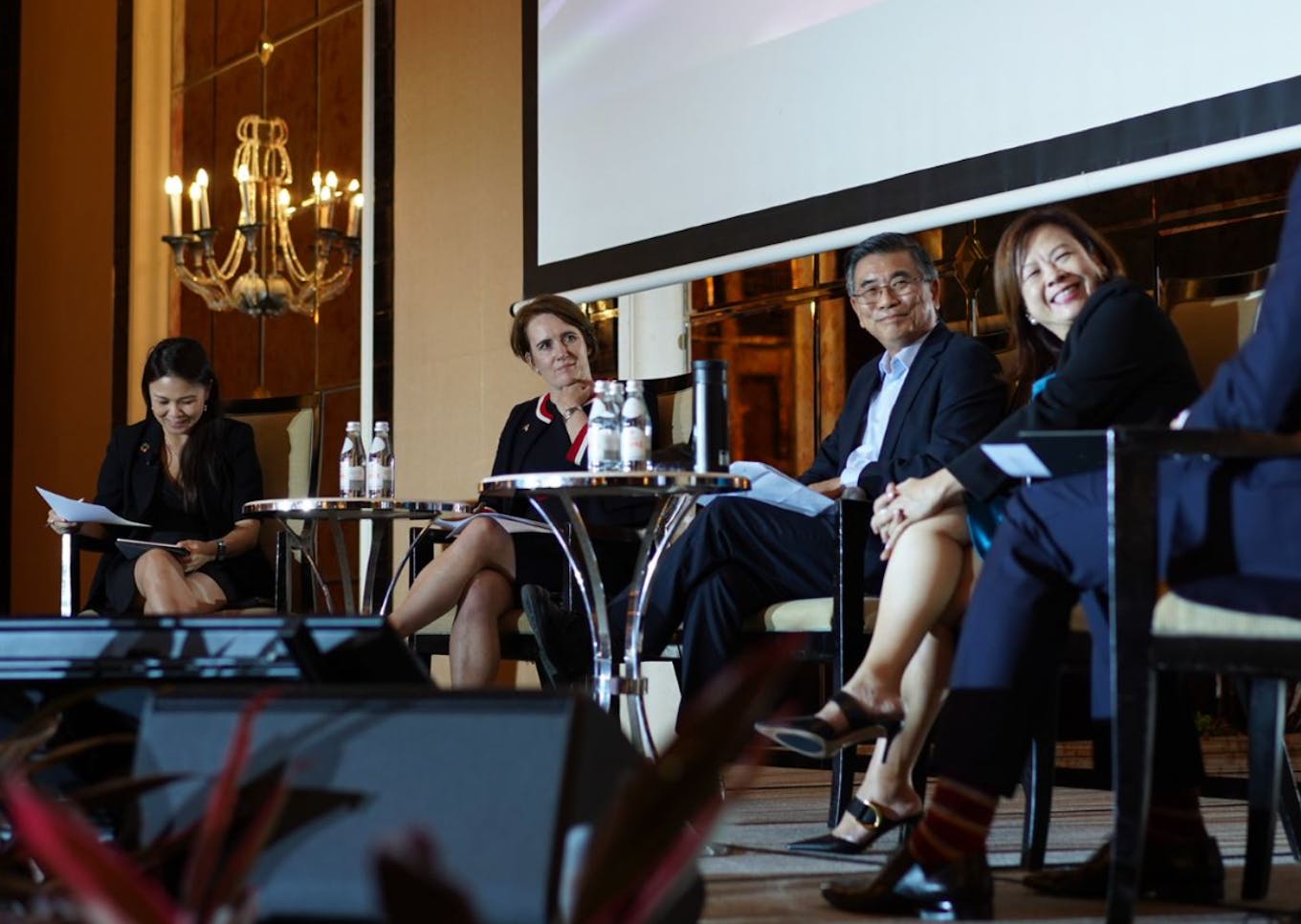To keep global warming to under 1.5 degrees Celsius and avoid catastrophic climate change, the world must halve its emissions by 2030 and achieve net zero emissions by 2050.
“The alarm bells are ringing particularly loudly for those of us in the Asean [Association of Southeast Asian Nations) region,” said British High Commissioner to Singapore Kara Owen in her opening keynote address at the Cities: Possibilities 2021 forum held in Singapore on 3 November.
“If we don’t get a grip on climate change, it could cut over 35 per cent of the region’s gross domestic product (GDP) by the middle of this century, and urban populations will endure the health and wellness impacts of increases in temperature and high levels of pollution.”
Organised by Eco-Business, the annual forum in its third edition convened over 600 high-level decision makers from the building, finance and infrastructure sectors, government, civil society and academia to discuss latest developments in advancing Sustainable Development Goal 11 – creating sustainable cities and communities.
“
The direction is very clear: you should be asking how fast you can get to net zero.
Esther An, chief sustainability officer, City Developments Limited
Held in the same week as the 2021 United Nations Climate Change Conference, also known as COP26, the speakers highlighted pathways to net zero for cities, and opportunities and challenges across Asia in the next decade.
Pathways to net zero
Governments, businesses and residents all have parts to play in enabling cities to attain net zero emissions, the speakers said during the forum’s opening plenary.
“Cities and states can set net zero commitments by 2050 with credible short-term strategies. They can define specific commitments on sector transformations, for example in buses or in buildings. They can mobilise key stakeholders to showcase place-based policymaking that works,” explained Owen.
Esther An, chief sustainability officer of real estate group City Developments Limited (CDL), added that going green is in firms’ self-interest as investors and consumers increasingly favour sustainable businesses.
“If you don’t have net zero goals and strategies, you may not get investors, banks may not lend you money, and insurance companies may not insure your properties if they are deemed as facing very high climate threats. The direction is very clear: you should be asking how fast you can get to net zero,” she said.
As cities and businesses set out net zero plans, they also need to keep people in mind, said Professor Lam Khee Poh, dean of the National University of Singapore’s School of Design and Environment, and its Provost’s Chair Professor of Architecture and Building.
“Smart technologies can make our buildings more and more efficient, but we tend to neglect the effort, knowledge and education that needs to go into training the people who will have to operate these smart buildings day in day out,” he elaborated.
Channelling finance into eco-friendly projects is also key, stressed Wayne Gordon, UBS bank’s executive director, chief investment office, global wealth management. He said: “We’ve seen the proliferation of different ways in which finance can engage with development, including through green bonds and sustainability-linked bonds.”
“It’s also incumbent on wealthier countries to help less wealthy countries,” he added.
Five areas crucial to net zero
In the forum’s second half, delegates joined roundtable discussions in five areas critical to net zero ambitions: buildings; mobility; big data, artificial intelligence (AI), Internet of Things (IoT) and the cloud; food and agricultural technology; and resources and the circular economy.
Speakers shared insights from the discussions during the forum’s closing plenary. “If we want to transform the building sector, we need to look at the entire value chain starting from the sites we choose to the buildings we create, down to the people who use the buildings,” said Kevin Hsu, senior assistant director of the Centre for Liveable Cities.
“When we consider sites for development, for example, we need to have better accounting frameworks that analyse their ecological value, urban heat island impact, social and heritage value, and many other factors. If we develop a site, we must replace displaced greenery with carbon sinks of equivalent function, not just put any greenery back,” he continued.
“
The challenge that the developed world faces is in reversing the damage that has been done in existing cities. In emerging countries the challenge is in building the right type of urban environments for their cities of tomorrow.
Khong Weng Fook, managing director, Canopy Sands
Sreekanth APV, business unit leader, mobility, for the Singapore branch of global design and consulting firm Arcadis, noted that the Covid-19 pandemic has spurred more governments to redesign cities so residents can fulfil their daily needs near their homes.
“Every form of mobility from shipping to land transport has its own challenges when it comes to getting to net zero, but traveling less is a good place to start,” he said. He added that there are plenty of investment opportunities for green transport, from developments in electric vehicles to systems that facilitate mobility as a service.
Smart devices are crucial to accomplishing net zero emissions, added Jonathan Tan, managing director of IoT service provider UnaBiz. “By deploying smart meters that transmit usage data, you don’t need people traveling in vehicles to collect the data, cutting down on emissions,” he gave as an example.
Achyuth Iyengar, global nutrition, health and sustainable living firm DSM’s director, specialty solutions, animal nutrition and health, Asia Pacific, zeroed in on food systems’ inefficiencies and opportunities. “We must use science to deliver sustainable, scalable solutions, such as food fortification to fight malnutrition, and making alternative proteins more affordable.”
To encourage circular economies and better use of resources, governments can set regulatory frameworks, firms can share data on their resource usage and best practices, and people can adopt greener habits, said Nini Purwajati, senior manager, programmes and knowledge, at the Resilient Cities Network.
“We also need to recognise that cities from developing countries that are grappling with basic needs may face challenges with budgets and technical capacities. Cities like Singapore can play a leadership role in helping others to advance circular economies,” she said.

Speakers at Cities Possibilities 2021. Left to right: Eco-Business managing directior Jessica Cheam, British High Commissioner to Singapore Kara Owen, Professor Lam Khee Poh, dean of the National University of Singapore’s School of Design and Environment, and Esther An, chief sustainability officer, City Developments Limited
‘A historic moment for humanity’
In a special keynote address, Khong Weng Fook, managing director of real estate developer Canopy Sands Development, said that cities are crucial to the fight against climate change.
“Cities are a primary focus when we talk about climate action today. The challenge that the developed world faces is in reversing the damage that has been done in existing cities. In emerging countries including Cambodia, the challenge is in building the right type of urban environments for their cities of tomorrow,” he said.
Owen noted that some 90 per cent of global GDP is now covered by net zero commitments, up from about 30 per cent just two years ago, setting the stage for COP26 to enable a profound sea-change globally on climate action.
She said: “This is a historic moment for humanity, and we all need to step up at this critical hour. There is a bigger coalition than ever before for us to get to net zero, and we need to harness the momentum, urgency and hope that we can do it if we work together.”

















